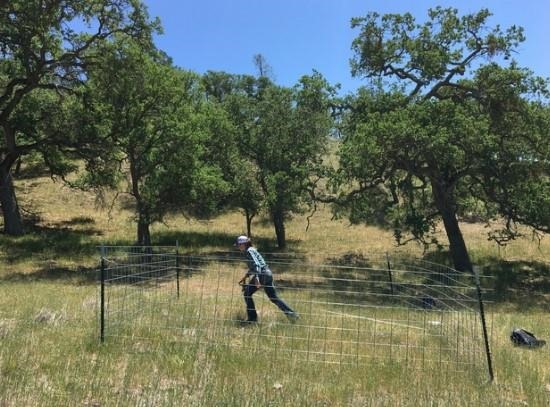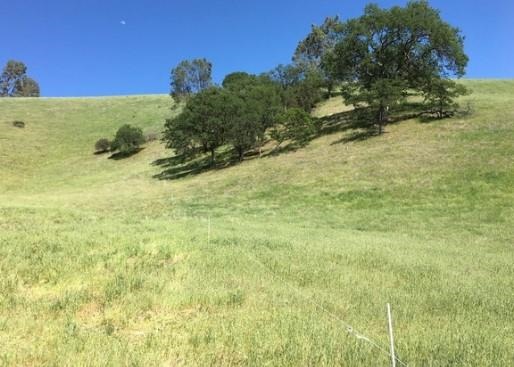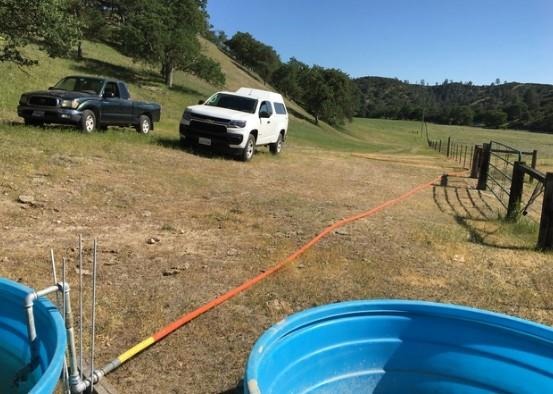By Devii R. Rao
Liz Reikowski is a San Benito County rancher who recently graduated with a master's degree in Natural Resources Management from University of Nevada, Reno (Figure 1). Liz and her brother Matt own and manage Willow Creek Land and Cattle (WCLC), a small cattle ranching business in south San Benito County. In 2020, Liz received a Western SARE Farmer / Rancher grant to test two hypotheses: 1) if targeted rotational grazing can improve ecological health and 2) whether targeted rotational grazing as a business practice is practical and profitable for ranchers. Specific ecological health objectives of the grant are to use targeted rotational grazing to
- Increase cover and density of native perennial grasses
- Increase cover of native forbs (wildflowers)
- Reduce cover of two weeds: tocolote (Centaurea melitensis) and black mustard (Brassica nigra)
Liz is testing her grazing strategy at two ranches in southern San Benito County: Pinnacles Ranch and the Selleck Ranch. Pinnacles Ranch is about 200 acres of grassland and oak woodland, which are grazed by one bull and 23 heifers (Figure 2). Most of the cattle are not owned by WCLC and the owner of the cattle pays WCLC a daily fee to graze his cattle. The Selleck Ranch is 630 acres of grassland, oak woodland and chaparral. One hundred thirty acres of the Selleck Ranch are currently grazed and the remainder of the ranch will be grazed starting in fall 2021, following the installation of a stock water system. WCLC typically grazes cattle from December thorugh June. However, because of the drought this year, cattle were only grazed at Pinnacles Ranch from February-June. Paddocks at the two ranches range from 6-25 acres. Cattle remain in each paddock for about two weeks before they are rotated to the next one.

Figure 2. WCLC’s cattle.
In order to test her first hypothesis, this year Liz set up plots inside four grazing exclosures at Pinnacles Ranch (Figure 3) and six exclosures at the Selleck Ranch. Each ungrazed exclosure is paired with a nearby grazed plot. WCLC started grazing at Pinnacles Ranch in December 2018. So, while 2021 is the third season of grazing, it is the first year of vegetation sampling associated with the Western SARE grant. The first year of both rotational grazing and vegetation sampling at the Selleck Ranch will be in 2022. The grant is paying for Liz's time to monitor the plots.

Figure 3. Setting up line-point intercept transect in grazing exclosure.
The landowner at Pinnacles Ranch is very interested in the ecological outcomes of livestock grazing compared to no livestock grazing on his ranch. Prior to 2018, there was no livestock grazing on the ranch. This project will provide some results to help answer his questions.
In addition to the grant-funded plots, Liz set up 12 permanent line-point intercept plots at Pinnacles Ranch when WCLC started grazing the ranch in December 2018. Those plots are not related to the Western SARE grant and she is not getting paid to monitor them. Liz said that so far, trend data on those 12 grassland plots suggest that her rotational grazing strategy, which includes a significant period of rest, is helping to increase native perennial grasses. She noted that her rotational grazing helps reduce thatch buildup and competition from annual grasses while allowing enough time for perennial grasses to recover and regrow following grazing. However, she has not seen this same benefit for forbs yet and expects that more years of data collection are needed to detect trends in forb cover. She hypothesizes that compared to continuous grazing, rotational grazing allows more grass regrowth, which could lead to a longer growing season. Liz also noted that this grazing strategy keeps more biomass in the system, explaining that she doesn't want not too much thatch because it limits growth of native plants, but she does want a light level of thatch which she said increases water retention and thus the growing season. In addition to allowing for long periods of recovery between grazing periods (anywhere from 90 days to a full year), WCLC stocks lightly enough that more grass grows than is used by the livestock. This ensures that the ranches that they graze have a “grass bank” available to feed cattle in dry years, such as this one.
The owner of Pinnacles Ranch is also very interested in the influence of livestock on oak recruitment, so through the SARE grant Liz also set up oak woodland monitoring plots where she counts oak seedlings in different size classes every year. Liz hopes to see the density and height of oak seedlings increase over time. The growth and survival of oak seedlings could be limited by cattle feeding on the young oaks, or alternatively, oak seedlings might benefit from reduced competition from annual grasses other weeds. Liz will consider her targeted rotational grazing a success if the native grasses or forbs increase, while tocolote and black mustard decrease in the grazed areas compared to the ungrazed exclosures. It will be difficult to see any vegetation changes in three years of this grant, so she is interested in applying for other grants to pay for more years of data collection.
In addition to the ecological benefits, Liz is delving into the potential financial benefits of her rotational grazing strategy. She has several questions on this topic:
- Will targeted rotational grazing increase the grazing season? If so, will that increase weight gains on cattle?
- How do cattle perform when they graze in a more confined area with less choice in what they eat? Using SARE grant funds, Liz bought a livestock scale to compare weight gains on her cattle to what would be expected for more traditional cattle grazing operations in the area.
- Will the knowledge and experience she gains through this research allow her secure less costly grazing leases with people who want to use grazing for ecological outcomes?
- Will this experience allow her to get more grants?
- Will the benefits of a longer growing season, less expensive leases, etc. outweigh the cost of buying portable electric fence, portable water troughs, trucking cattle, and WCLC's time to do more intensive livestock and infrastructure management?
Answers to these questions will help WCLC with business planning as their operation grows.
At this stage, portable electric fence and portable water systems (Figures 4 and 5) keep the operation going. But, in the long run Liz would like to see more permanent infrastructure, particularly water systems, set up on WCLC's grazing leases. Click here to watch a 30-second video of Liz explaining how she uses a solar panel to power her electric fence. And here's a short video of Liz demonstrating how to create a gate in an electric fence.

Figure 4. Single strand electric fence keeps the cattle in the field.

Figure 5. Portable water troughs with floats are connected to the permanent water line with orange HDPE hose.
Portable water troughs are crucial for WCLC's targeted grazing operation because their two grazing leases do not have adequate permanent water infrastructure. Figure 5 shows a portable water trough and portable water line (orange hose) that taps into the existing permanent water line next to barn. Water is gravity fed to the trough and is maintained at the right level with the help of a float. The portable water line is made from HDPE (high-density polyethylene), which is a flexible and sturdy alternative to PVC. It comes in big reels and that can be attached to a pickup and is pulled it out like a hose. It can withstand cattle walking on it, but Liz cautions not to drive over it. Although, there are some portable water lines that can be driven over. These temporary water lines could be made permanent by burying them. If they are left above ground for too long, they can become brittle and break. Ideally, Liz would like to start installing a permanent water system to minimize the amount time she spends setting up and maintaining the existing system, and to minimize the wear and tear on her pickup's suspension that occurs when she needs to truck water to locations that the portable water lines don't reach.
Through this Western SARE grant, Liz will analyze the ecological data and write a paper to share her results. A separate study looking at costs and returns associated with her grazing operation will also be conducted.
Source : ucanr.edu